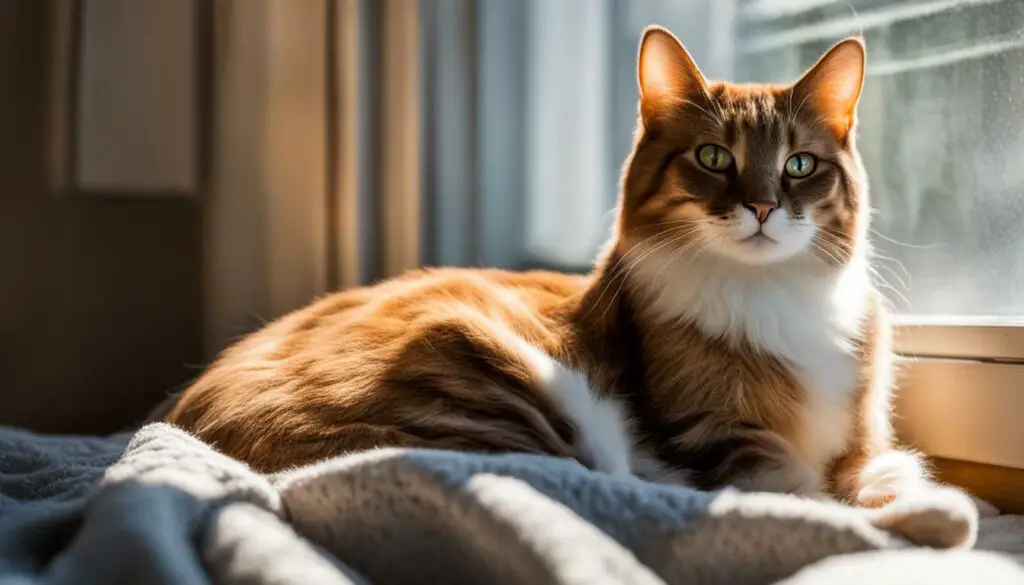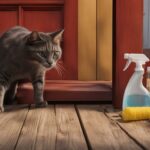As a cat owner, I understand the importance of ensuring the comfort and well-being of our feline companions. But what about declawed cats? This controversial procedure can cause physical and psychological damage, making it crucial for us to find ways to enhance their comfort and improve their quality of life. In this article, I will share some simple tips and strategies that can help create a more comfortable environment for your declawed cat, ensuring they live a happy and stress-free life.
Key Takeaways:
- Declawing can have long-term consequences and cause pain for cats.
- Addressing pain after declawing is essential for their well-being.
- Flower essences and homeopathic remedies can provide relief.
- Regular paw health practices like massaging and stretching are beneficial.
- Nail trimming and nail caps can prevent damage caused by scratching.
Treating Declaw Pain
If you suspect that your cat is experiencing pain after declawing, it’s important to address it effectively. There are several cat declawing recovery tips you can follow to manage their pain and promote healing.
Gabapentin is an anti-seizure medication that can be prescribed by your veterinarian to provide relief for your cat. It helps alleviate pain and reduce inflammation. Proper dosage and administration instructions should be followed to ensure its effectiveness and safety.
In addition to medication, meridian therapy techniques like EFT (Emotional Freedom Techniques) and energy work such as Reiki can also help alleviate pain and promote healing in declawed cats. These holistic approaches focus on balancing the body’s energy and can provide relief from both physical and emotional discomfort.
By combining these treatment options, you can help manage your cat’s pain and promote a more comfortable recovery after declawing.
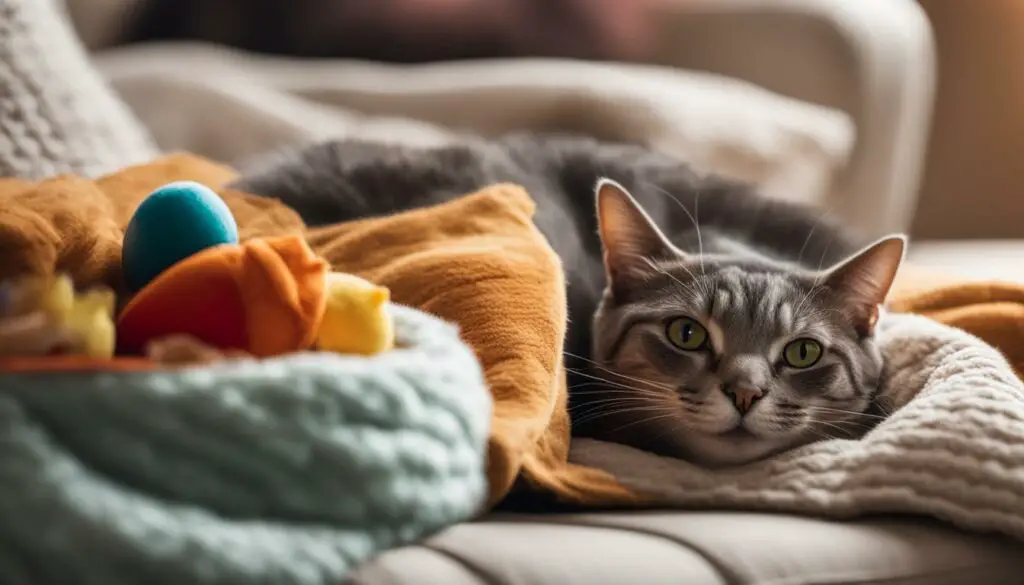
Treating Declaw Pain – Summary:
- Addressing pain after declawing is crucial for your cat’s well-being.
- Gabapentin, an anti-seizure medication, can provide relief and reduce inflammation.
- Meridian therapy techniques like EFT and Reiki can help alleviate pain and promote healing.
- Combining different treatment options can effectively manage your cat’s pain and improve their comfort during recovery.
| Treatment Options | Description |
|---|---|
| Gabapentin | An anti-seizure medication that helps alleviate pain and reduce inflammation. |
| Meridian Therapy (EFT and Reiki) | Holistic approaches that focus on balancing the body’s energy to provide relief from both physical and emotional discomfort. |
Using Flower Essences for Healing
When it comes to comforting strategies for declawed cats, flower essences can be incredibly beneficial. These natural remedies contain the energetic properties of flowers and can help promote relaxation and emotional well-being in declawed cats. Flower essences work on a vibrational level, addressing both physical pain and the psychological impact of declawing.
One effective option to consider is a special “Declaw Remedy” that is specifically designed to support declawed cats. This remedy may contain a blend of flower essences that target common issues such as anxiety, fear, and stress. By adding a few drops of the remedy to your cat’s water or food, or applying it directly to their fur, you can provide them with a gentle and non-invasive way to find comfort and healing.
Some popular flower essences that are often used for declawed cats include Bach Rescue Remedy, Walnut, and Star of Bethlehem. Bach Rescue Remedy is known for its ability to alleviate stress and promote a sense of calm. Walnut can help with the adjustment period after declawing, while Star of Bethlehem is believed to assist in healing emotional trauma.
Before introducing flower essences to your declawed cat, it’s important to consult with a holistic veterinarian who is knowledgeable about their use. A professional can recommend the appropriate essences and provide guidance on the correct dosage and administration methods. By incorporating flower essences into your cat’s routine, you can help promote relaxation and overall well-being in your beloved feline companion.

Promoting Relaxation in Declawed Cats
| Benefits of Flower Essences for Declawed Cats | How to Use Flower Essences for Declawed Cats |
|---|---|
|
|
Taking Care of Declawed Cats: Managing Post-Operative Pain and Care
Managing the pain and ensuring proper post-operative care are crucial factors in the well-being of declawed cats. While the procedure itself is irreversible, there are measures you can take to aid their recovery and minimize discomfort. By implementing these strategies, you can enhance your declawed cat’s comfort and promote a smoother healing process.
Post-Operative Pain Management
After declawing, your cat may experience pain and discomfort in their paws. It is essential to work closely with your veterinarian to provide effective pain relief. Medications such as buprenorphine or meloxicam can be prescribed to alleviate pain and reduce inflammation. Follow the recommended dosage and ensure your cat receives the medication as directed.
Additionally, creating a calm and soothing environment can help alleviate stress and anxiety, promoting faster healing. Provide a cozy bed or padded area for your cat to rest, away from any loud noises or high-traffic areas. Minimize activity and playtime during the recovery period to prevent further strain on their paws.
Proper Wound Care
Proper wound care is essential to prevent infection and promote healing. Keep the litter box clean and use unscented, dust-free litter to avoid any irritation. Monitor the incision sites for any signs of redness, swelling, or discharge. If you notice any abnormalities or concerns, contact your veterinarian immediately.
It is essential to prevent your cat from scratching or licking the incision sites. Use an Elizabethan collar (e-collar) or alternative protective measures, such as soft fabric sleeves, to prevent them from irritating their paws. Regularly check the e-collar or sleeves for any signs of rubbing or discomfort.
| Signs of Infection | Signs of Healing |
|---|---|
|
|
Caring for Their Emotional Well-being
Declawing can have psychological effects on cats, as it removes their natural defense mechanism. Providing environmental enrichment and engaging activities can help alleviate stress and promote a positive emotional state. Interactive toys, scratching posts, and vertical spaces for climbing can redirect their attention away from their paws and encourage natural behaviors.
It is essential to offer your declawed cat plenty of love, attention, and positive reinforcement. Reward them with treats or praise when they exhibit desirable behavior. This can help build trust and confidence, aiding in their overall well-being.
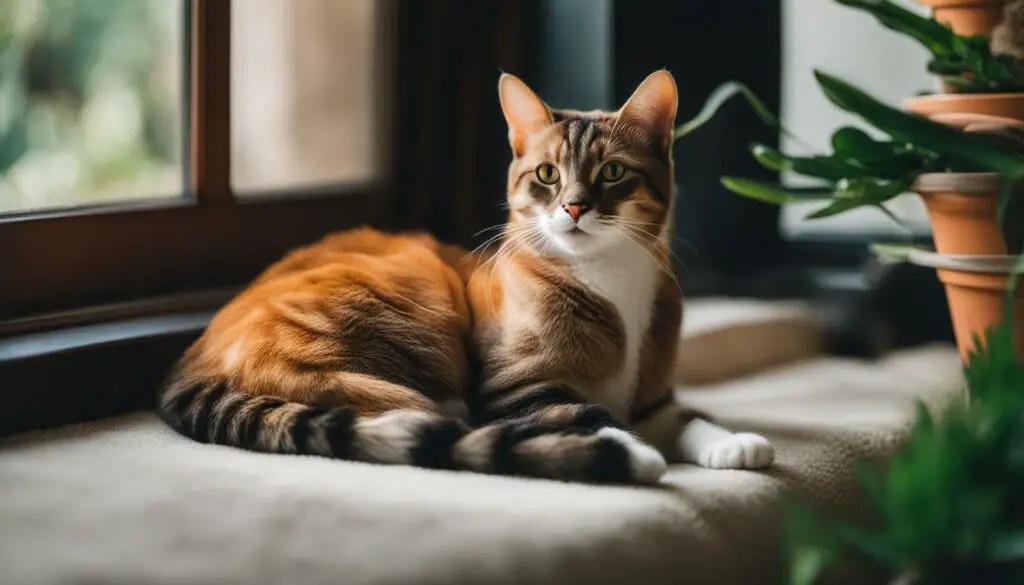
By prioritizing post-operative pain management and providing proper care, you can help your declawed cat recover comfortably and minimize any potential complications. Remember to consult with your veterinarian for personalized advice and guidance throughout the recovery process.
Massaging and Stretching for Paw Health
When it comes to providing comfort for your declawed cat, paying attention to their paw health is crucial. Regularly massaging and stretching their toes and paws can help prevent tendon contraction and minimize the development of arthritis. This simple practice can promote overall paw health and contribute to your cat’s comfort.
Massaging your cat’s paws involves gently applying pressure to the pads and rubbing in circular motions. This helps improve blood circulation and relaxes the muscles. Additionally, stretching their toes gently can help maintain flexibility and prevent stiffness.
To perform a paw massage, start by finding a quiet and comfortable space where your cat feels relaxed. Sit on the floor with your cat in your lap or beside you. Gently hold their paw and apply slight pressure to the pads using your thumb and fingers. Massage each paw for a few minutes, paying attention to any signs of discomfort or sensitivity. If your cat shows discomfort, stop and consult with your veterinarian.
Stretching your cat’s toes can be done by gently extending and flexing their toes one by one. Hold each toe for a few seconds and then release. Be careful not to apply excessive force or cause any pain to your cat. If your cat resists or shows discomfort during the stretching, it’s best to consult with a veterinarian or a professional animal therapist for guidance.
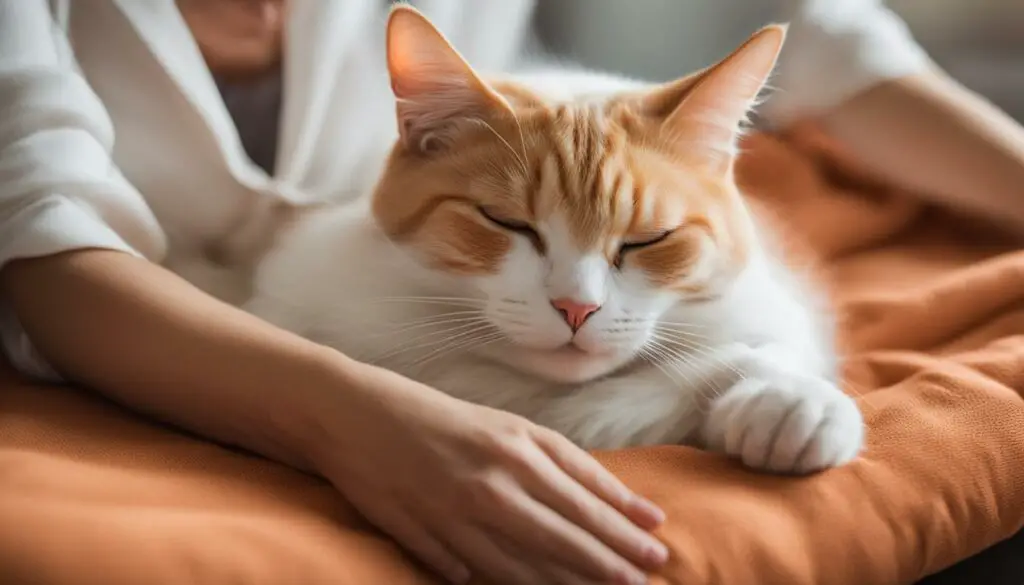
Benefits of Massaging and Stretching for Paw Health
Massaging and stretching your declawed cat’s paws can offer several benefits. It helps improve their circulation, reduces muscle tension, and promotes relaxation. This practice can also maintain their range of motion, preventing paw stiffness and the development of arthritis. By incorporating regular paw massages and stretches into your cat’s routine, you can contribute to their overall comfort and well-being.
Considering Flexor Tendonectomy Salvage Surgery
Declawed cats may experience ongoing pain or complications such as bone fragments, even after the initial declawing procedure. In severe cases where these issues persist, flexor tendonectomy salvage surgery may be a viable option for managing their post-operative care and pain.
This surgical technique involves the removal of the flexor tendons in the cat’s paws, which can help alleviate pain and reduce the risk of further complications. By preventing the flexor tendons from contracting, the surgery aims to promote healing and improve the overall comfort of the cat.
It is important to note that flexor tendonectomy salvage surgery should only be considered in severe cases where other treatment options have been exhausted and the cat’s quality of life is significantly impacted. Consulting with a veterinarian experienced in this procedure is crucial to determine whether it is appropriate for your cat’s specific situation.
| Pros | Cons |
|---|---|
|
|
Flexor tendonectomy salvage surgery should only be considered after exhausting all other treatment options and consulting with a veterinarian experienced in this procedure. The decision to proceed with the surgery should be based on the severity of the cat’s condition and its impact on their quality of life.
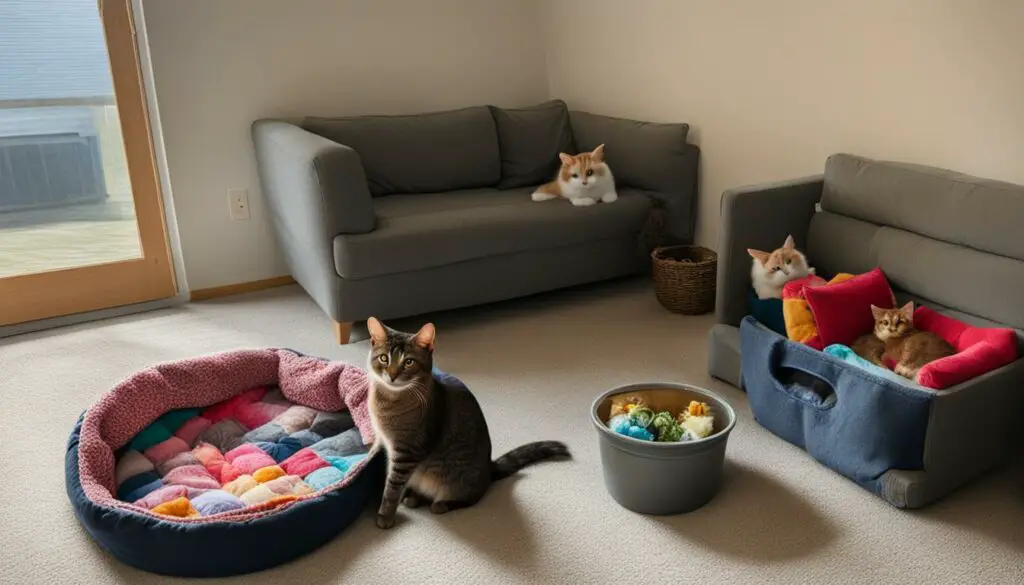
It is essential to provide appropriate post-operative care following flexor tendonectomy salvage surgery. This includes keeping the incision site clean and monitoring for signs of infection. Your veterinarian will provide detailed instructions on pain management, wound care, and any necessary follow-up appointments.
By considering flexor tendonectomy salvage surgery as a treatment option for your declawed cat, you can potentially alleviate their ongoing pain and improve their overall comfort and quality of life. However, it is crucial to fully evaluate the risks, benefits, and suitability of this procedure for your cat before making a decision.
Understanding the Consequences of Declawing
Declawing is an irreversible procedure that has long-term consequences for cats. While it may seem like a solution to prevent scratching-related damage, it is important to recognize the physical and psychological toll it takes on our feline friends. Declawing involves the amputation of the cat’s third phalanx bone, which can lead to chronic pain, balance issues, and behavioral changes.
One of the main consequences of declawing is the potential for long-lasting discomfort. Even after the recovery period, many declawed cats continue to experience pain. The removal of the claws also alters the cat’s balance, making it difficult for them to walk, jump, and climb like they used to. This can lead to frustration and a decreased quality of life for the cat.
Moreover, declawing can result in changes in behavior. Cats may become more aggressive or fearful due to the constant discomfort they experience. They may also develop litter box aversion as a result of the pain associated with digging in the litter. These behavioral issues can further diminish the cat’s comfort and overall well-being.
| Consequences of Declawing | Description |
|---|---|
| Chronic pain | The amputation of the third phalanx bone leads to ongoing pain for declawed cats. |
| Balance issues | Declawing affects a cat’s ability to walk, jump, and climb, leading to a diminished sense of balance. |
| Behavioral changes | Declawed cats may exhibit aggression, fearfulness, and litter box aversion due to the physical and psychological impact of the procedure. |
“Declawing may seem like a quick fix, but it is important to consider the long-term consequences it can have on your cat’s wellbeing. There are alternative options available that can address scratching behaviors without resorting to such a drastic and painful procedure.” – Dr. Emily Johnson, Veterinarian
As responsible pet owners, it is crucial that we understand the consequences of declawing and explore alternative methods to enhance the comfort and quality of life for our declawed cats. By providing appropriate scratching surfaces, implementing positive reinforcement techniques, and seeking out non-surgical solutions such as nail caps, we can ensure our feline companions live happier and more fulfilling lives.
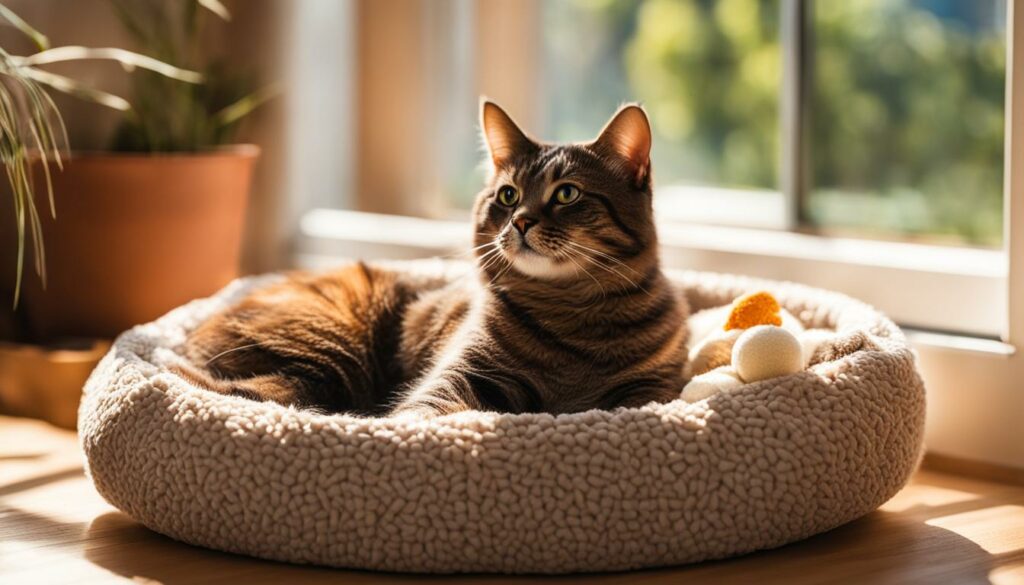
Educating Yourself on Alternatives to Declawing
Before resorting to declawing, it’s essential to explore alternative options. Declawing is a controversial procedure with potential long-term consequences for cats, both physically and psychologically. By educating yourself on alternative solutions, you can make a more informed decision that prioritizes your cat’s well-being and comfort.
One effective alternative to declawing is training your cat to use scratching posts. Provide multiple scratching posts throughout your home and encourage your cat to use them by placing treats or catnip nearby. Additionally, ensure that the scratching posts are tall enough for your cat to fully stretch and scratch. Positive reinforcement techniques, such as praising and rewarding your cat for using the scratching posts, can also help redirect their scratching behavior.
Another option is providing appropriate scratching surfaces, such as scratching pads or boards. These alternatives mimic the texture and sensation of scratching on a variety of surfaces, satisfying your cat’s natural instinct to scratch without causing damage to furniture or other belongings. Experiment with different types of scratching surfaces to find the one that your cat prefers.
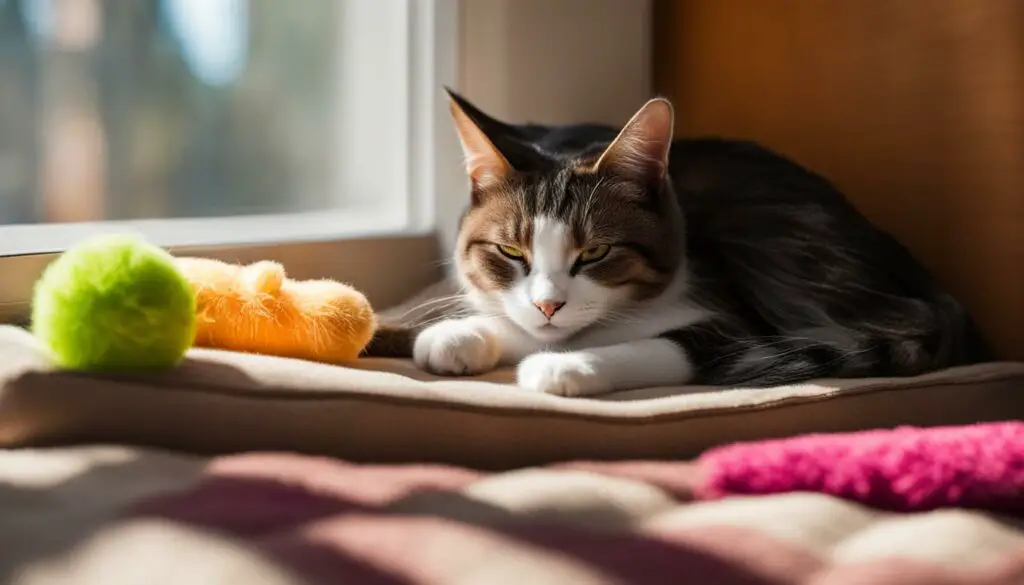 If your cat is particularly prone to scratching furniture in specific areas, you can also use deterrents to discourage this behavior. Double-sided tape, aluminum foil, or citrus-scented sprays can act as effective deterrents that make the furniture less appealing to your cat.
If your cat is particularly prone to scratching furniture in specific areas, you can also use deterrents to discourage this behavior. Double-sided tape, aluminum foil, or citrus-scented sprays can act as effective deterrents that make the furniture less appealing to your cat.
| Alternatives to Declawing | Benefits |
|---|---|
| Training your cat to use scratching posts | Redirects scratching behavior to appropriate surfaces |
| Providing appropriate scratching surfaces | Satisfies the natural instinct to scratch |
| Using deterrents on furniture | Discourages scratching on specific areas |
By exploring these alternatives and implementing them in your cat’s environment, you can enhance their comfort and prevent the need for declawing. Remember to be patient and consistent with the training process, as it may take some time for your cat to adjust to the new scratching surfaces. Ultimately, prioritizing your cat’s well-being and providing them with appropriate outlets for their natural behaviors can lead to a happier and stress-free coexistence.
The Importance of Nail Trimming
Managing pain after cat declawing and providing proper post-operative care is crucial for the comfort and well-being of your declawed cat. One essential aspect of declawed cat care is nail trimming. Regularly trimming your cat’s nails not only helps prevent damage caused by scratching but also ensures their claws remain at a safe length, reducing the risk of injury or discomfort.
Nail trimming can be a simple and stress-free process when done correctly. Start by familiarizing your cat with the handling of their paws from an early age, using positive reinforcement techniques such as treats and praise. Use cat-friendly nail clippers or a grinder designed specifically for cats’ claws, as human nail clippers can cause discomfort or injury. Always ensure you have good lighting and a calm environment when trimming your cat’s nails.
To trim your cat’s nails, gently hold their paw and press on the pad to extend the claws. Trim the tip of each nail, being careful not to cut too close to the quick, which is the pink area inside the nail. If you’re unsure, it’s better to trim a small amount at a time rather than risk cutting too much. Keep styptic powder or cornstarch on hand to stop any bleeding that may occur if you accidentally cut into the quick.
Benefits of Regular Nail Trimming:
- Prevents scratching-related damage to furniture and surfaces
- Reduces the risk of claw overgrowth, which can lead to discomfort and difficulty walking
- Minimizes the likelihood of accidental scratches or injuries to both humans and other pets
- Promotes good paw health by preventing ingrown nails or curling
By incorporating regular nail trimming into your declawed cat’s grooming routine, you can help them stay comfortable and minimize any potential issues associated with their altered claws. Remember to approach nail trimming with patience and positive reinforcement, ensuring a stress-free experience for both you and your feline companion.
| Nail Trimming Tips | |
|---|---|
| Start nail trimming practice from an early age to familiarize your cat with the process. | |
| Use cat-friendly nail clippers or a grinder designed for cats to prevent discomfort or injury. | |
| Provide a calm environment and good lighting when trimming your cat’s nails. | |
| Gently hold your cat’s paw and extend the claws by pressing on the pad. | |
| Trim the tip of each nail, avoiding cutting too close to the pink area (quick) inside the nail. | |
| Trim a small amount at a time and have styptic powder or cornstarch on hand to stop bleeding if necessary. |
Exploring Nail Caps as a Solution
One comforting solution for declawed cat paws is the use of nail caps. Nail caps are blunt acrylic caps that can be applied to your cat’s claws to prevent scratching-related damage. They provide protection for furniture and minimize the risk of injury, allowing your cat to maintain their natural scratching behavior without causing any harm.
Applying nail caps is a straightforward process. First, ensure that your cat’s claws are trimmed and clean. Then, gently squeeze the nail cap to open the adhesive, and carefully slide it onto the claw. Hold the cap in place for a few seconds to allow the adhesive to set. Repeat this process for each claw, and your cat will be ready to go.
Nail caps come in various sizes and colors, allowing you to choose the most suitable option for your cat. They are typically designed to last for around four to six weeks, depending on your cat’s activity level. Regularly check and replace any loose or worn-out caps to maintain optimal comfort and protection for your cat.
| Benefits of Nail Caps for Declawed Cats | Considerations |
|---|---|
|
|
Testimonial
“Ever since I started using nail caps on my declawed cat, I’ve noticed a significant difference in both her comfort and the preservation of my furniture. They are easy to apply and provide a safe alternative to declawing. I highly recommend nail caps to any cat owner looking for a comforting solution for their declawed cat’s paws.”
– Sarah, Cat Owner
By exploring nail caps as a solution for declawed cat paws, you can enhance the comfort of your feline companion while protecting your home. The application process is simple, and their benefits in preventing scratching-related damage are worthwhile. Remember to consult with your veterinarian for proper sizing and guidance to ensure the best experience for your cat.
Weighing the Pros and Cons of Declawing
Declawing cats is a controversial procedure that sparks discussions among pet owners, veterinarians, and animal rights activists. It’s important to carefully consider the potential risks and benefits before making a decision. Here, I will outline the key factors to help you weigh the pros and cons of declawing.
The Pros of Declawing
- Preventing damage: Declawing can prevent cats from scratching furniture, carpets, and other household items.
- Reducing injury risk: Removing a cat’s claws can help prevent scratches and bites, which is especially significant for households with young children or immunocompromised individuals.
- Improving adoption chances: Some individuals may be more willing to adopt a declawed cat due to personal preferences or living situations that prohibit scratching behavior.
The Cons of Declawing
- Pain and discomfort: Declawing involves the amputation of the last bone of each toe, which can cause acute pain, long-term discomfort, and potential complications.
- Behavioral changes: Cats may develop behavioral issues such as aggression or litter box problems after being declawed.
- Loss of natural defense mechanisms: Scratching is a natural behavior that allows cats to stretch, mark territory, and defend themselves. Declawing removes these important defense mechanisms.
Ultimately, the decision to declaw a cat should be approached with caution. It’s crucial to explore alternative options and implement strategies to manage scratching behavior effectively. Consulting with your veterinarian can provide valuable insights and help you make an informed choice that prioritizes the well-being and quality of life for your feline companion.
| Pros | Cons | |
|---|---|---|
| Potential Benefits | Preventing damage | Pain and discomfort |
| Reducing injury risk | Behavioral changes | |
| Improving adoption chances | Loss of natural defense mechanisms |
Understanding the AVMA’s Position on Declawing
The American Veterinary Medical Association (AVMA) discourages the declawing of cats as an elective procedure. They promote non-surgical alternatives and advocate for veterinarians to educate pet owners about natural scratching behaviors, alternative options, and the details and potential complications of the declawing procedure.
The AVMA’s stance is rooted in their commitment to promoting the comfort and well-being of declawed cats. They emphasize the importance of understanding the consequences of declawing and encourage pet owners to explore other solutions that can enhance the quality of life for their feline companions.
By discouraging declawing, the AVMA highlights the need for pet owners to educate themselves about the natural behaviors of cats and the importance of providing appropriate outlets for scratching. This includes providing scratching posts, offering positive reinforcement techniques to redirect scratching behavior, and considering alternatives such as nail caps.
Ultimately, the AVMA aims to empower pet owners with the knowledge and resources necessary to make informed decisions regarding the care and well-being of their declawed cats. By embracing non-surgical alternatives and promoting education, they strive to enhance the comfort and quality of life for these feline companions.
Conclusion
As a cat owner, I understand the importance of making a declawed cat more comfortable and improving their quality of life. While declawing is a controversial procedure with potential long-term consequences, there are steps you can take to enhance their well-being.
By implementing the tips and alternatives discussed in this article, you can create a happier and stress-free environment for your beloved feline companion. From providing pain relief and using flower essences to exploring homeopathic remedies and nail caps, each strategy plays a crucial role in improving the comfort of your declawed cat.
Remember, declawing is irreversible, but your dedication to their comfort can make a significant difference. By educating yourself on alternative options and understanding the consequences of declawing, you can make an informed decision that prioritizes the health and happiness of your furry friend.
FAQ
How can I make my declawed cat more comfortable?
By implementing strategies such as providing pain relief medication, using flower essences, and exploring homeopathic remedies, you can help alleviate your cat’s pain and promote healing.
What can I do to treat my cat’s pain after declawing?
Consider using gabapentin, a pain relief medication, to provide relief for your cat. Additionally, meridian therapy like EFT and energy work such as Reiki can also help alleviate pain and promote healing.
How can flower essences help my declawed cat?
Flower essences can be used to alleviate both physical and psychological pain in declawed cats. They can also help with any behavioral issues that may arise from the declawing procedure. Consider using a special “Declaw Remedy” designed specifically for this purpose.
Are there any homeopathic remedies that can help my declawed cat?
Hypericum, a homeopathic remedy specific to pain in fingers and toes, may be helpful. Consult with an experienced homeopathic veterinarian to determine the correct remedy, dosage, and timing.
How can I promote paw health in my declawed cat?
Regularly massaging and stretching your cat’s toes and paws can minimize tendon contraction and help prevent the development of arthritis. This simple practice can promote paw health and overall comfort for your declawed cat.
What is flexor tendonectomy salvage surgery?
In severe cases where declawed cats experience ongoing pain or complications such as bone fragments, flexor tendonectomy salvage surgery may be an option. Consult with a veterinarian experienced in this procedure to determine if it is suitable for your cat.
What are the consequences of declawing?
Declawing is an irreversible procedure that can have long-term consequences for cats. While nothing can fully reverse the physical damage of declawing, implementing strategies to alleviate pain and promote comfort can help improve your declawed cat’s quality of life.
What alternatives to declawing should I consider?
Before resorting to declawing, it’s essential to explore alternative options such as training your cat to use scratching posts, providing appropriate scratching surfaces, and using positive reinforcement techniques to redirect their scratching behavior.
How important is nail trimming for declawed cats?
Regularly trimming your cat’s nails can help prevent damage caused by scratching. Learning the proper technique for nail trimming and incorporating it into your cat’s grooming routine can contribute to their comfort and well-being.
Are there any solutions to prevent scratching-related damage without declawing?
Blunt acrylic nail caps can be applied to your cat’s claws as a temporary solution to prevent scratching-related damage. These caps can be an effective alternative to declawing, providing protection for furniture and minimizing the risk of injury.
What are the pros and cons of declawing?
Declawing is a controversial procedure with both advocates and opponents. It’s important to consider the potential risks and benefits before making a decision. Educate yourself on the facts surrounding declawing and consult with your veterinarian to make an informed choice.
What is the AVMA’s position on declawing?
The American Veterinary Medical Association (AVMA) discourages the declawing of cats as an elective procedure. They promote non-surgical alternatives and advocate for veterinarians to educate pet owners about natural scratching behaviors, alternative options, and the details and potential complications of the declawing procedure.

